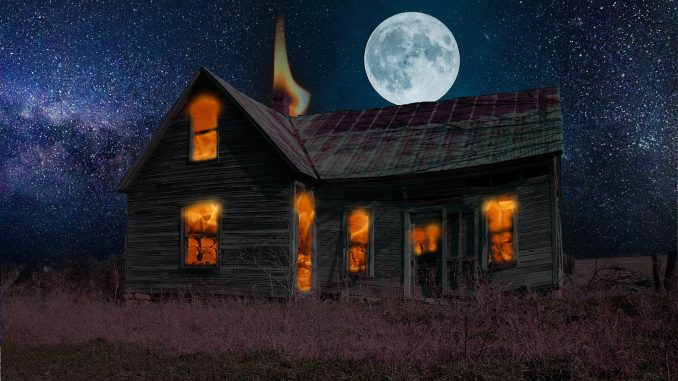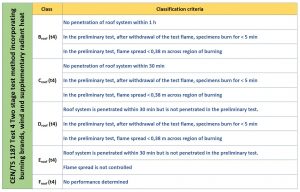
Introduction
In this fourth and last post of the thematic series on roofs exposed to the external fire, I will explain you the fourth test method included in the technical specification CEN/TS 1187. This method consists of two stages test method incorporating burning brands, wind and supplementary radiant heat.
Method 4, method with two stages incorporating burning brands, wind and supplementary radiant heat.
This test method consists of two clearly differentiated stages. In the first one, the specimen is exposed to a preliminary ignition test with burning brands for 1 minute. The second stage the specimen would be exposed to the effect of the thermal radiation provided by a radiant panel. After 5 minutes under these conditions, a burning brand would be applied on the surface of the specimen for 1 minute and the required wind conditions. The duration of the test is 1 hour.
The test brand will be simulated by a flame with a height of 230 mm. To simulate the wind conditions of 6,7 m/s, a suction is applied on the lower side of the specimen. The radiant panel will consist of four square panels with dimensions of 480 mm on each side. It will be located at 585 mm of the specimen and will provide 12 kW/m2.
For the first part of the test, one specimen with dimensions of (840 x 840) mm is required, unlike the second part of the test where three specimens with the same dimensions as the first part of the test are required. In both parts of the test, the specimens must be representative of the complete roof in its end use condition.
Specimens that are planned to be installed with a pitch greater than 10° will be tested with an inclination of 45°. Otherwise, the system roof must be tested with a pitch of 0°, that is, horizontally. However, like other test methods explained for roofs, it is possible to test a specimen with a specific pitch. As it is known, in this type of cases, the result will be valid only for the pitch tested.
Concerning to the joints, at least one of the specimens must present a joint. The location of the joint/s will meet the following criteria.
- The joint in the insulation should be on the centre line of the specimen. When tested as a pitched roof, the joint shall run down the line of fall of the roof.
- One specimen shall have a lap-joint in the waterproofing membrane on the centre line of the specimen. When tested horizontally the joint may run in either direction.
The following factors are taken into account in the preliminary ignition test:
- Duration of the flame.
- Extension of flame spread.
- Time and nature of the penetration.
With regard to the second part, the following factors are considered:
- Time in which any penetration occurs.
- Occurrence of melting of the test specimens and the production of molten droplets or debris.
- Mechanical failure or the appearance of holes, without penetration by fire.
Classification system
As I explained in the first post of this thematic series, a classification standard is necessary to comply with national legislations. The standard EN 13501-5 will be applicable and offers for the test method 4, five possible classifications, Broof (t4), Croof (t4), Droof (t4), Eroof (t4) and Froof (t4). The classification criteria for the previous classes are shown below
The classification criteria for the previous classes are shown below:

Bibliography
CEN/TS 1187. Test methods for roofs exposed to external fire.
EN 13501-5. Fire classification of construction products and building elements – Part 5: Classification using data from external fire exposure to roofs tests